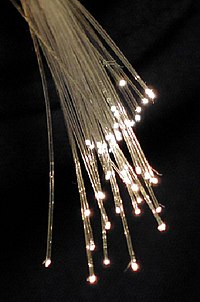
Photo from wikipedia
OBJECTIVE Optogenetic modulation of neural activity is a ubiquitous tool for basic investigation of brain circuits. While the majority of optogenetic paradigms rely on short light pulses to evoke synchronized… Click to show full abstract
OBJECTIVE Optogenetic modulation of neural activity is a ubiquitous tool for basic investigation of brain circuits. While the majority of optogenetic paradigms rely on short light pulses to evoke synchronized activity of optically sensitized cells, many neurobiological processes are associated with slow local field potential (LFP) oscillations. Therefore, we developed a hybrid fiber probe capable of simultaneous electrophysiological recording and optical stimulation and used it to investigate the utility of sinusoidal light stimulation for evoking oscillatory neural activity in vivo across a broad frequency range. APPROACH We fabricated hybrid fiber probes comprising a hollow cylindrical array of 9 electrodes and a flexible optical waveguide integrated within the core. We implanted these probes in the hippocampus of transgenic Thy1-ChR2-YFP mice that broadly express the blue-light sensitive cation channel channelrhodopsin 2 (ChR2) in excitatory neurons across the brain. The effects of the sinusoidal light stimulation were characterized and contrasted with those corresponding to pulsed stimulation in the frequency range of physiological LFP rhythms (3-128 Hz). MAIN RESULTS Within hybrid probes, metal electrode surfaces were vertically aligned with the waveguide tip, which minimized optical stimulation artifacts in neurophysiological recordings. Sinusoidal stimulation resulted in reliable and coherent entrainment of LFP oscillations up to 70 Hz, the cutoff frequency of ChR2, with response amplitudes inversely scaling with the stimulation frequencies. Effectiveness of the stimulation was maintained for two months following implantation. SIGNIFICANCE Alternative stimulation patterns complementing existing pulsed protocols, in particular sinusoidal light stimulation, are a prerequisite for investigating the physiological mechanisms underlying brain rhythms. So far, studies applying sinusoidal stimulation in vivo were limited to single stimulation frequencies. We show the feasibility of sinusoidal stimulation in vivo to induce coherent LFP oscillations across the entire frequency spectrum supported by the gating dynamics of ChR2 and introduce a hybrid fiber probe tailored to continuous light stimulation.
Journal Title: Journal of neural engineering
Year Published: 2018
Link to full text (if available)
Share on Social Media: Sign Up to like & get
recommendations!